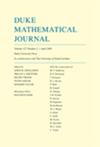Fourier multipliers in SLn(R)
IF 3
1区 数学
Q1 MATHEMATICS
引用次数: 8
Abstract
We establish precise regularity conditions for Lp-boundedness of Fourier multipliers in the group algebra of SLn(R). Our main result is inspired by Hörmander-Mikhlin criterion from classical harmonic analysis, although it is substantially and necessarily different. Locally, we get sharp growth rates of Lie derivatives around the singularity and nearly optimal regularity order. The asymptotics also match Mikhlin formula for a exponentially growing metric with respect to the word length. Additional decay comes imposed by this growth and Mikhlin condition for high order terms. Lafforgue/de la Salle’s rigidity theorem fits here. The proof includes a new relation between Fourier and Schur Lp-multipliers for nonamenable groups. In SLn(R), this holds in terms of Harish-Chandra’s almost L2 matrix coefficients. By transference, matters are reduced to a rather nontrivial RCp-inequality for SLn(R)-twisted forms of Riesz transforms associated to fractional laplacians. Our second result gives a new and much stronger rigidity theorem for radial multipliers in SLn(R). More precisely, additional regularity and Mikhlin type conditions are proved to be necessary up to an order ∼ | 1 2 − 1 p |(n − 1) for large enough n in terms of p. Locally, necessary and sufficient growth rates match up to that order. Asymptotically, extra decay for the symbol and its derivatives imposes more accurate and additional rigidity in a wider range of Lp-spaces. This rigidity increases with the rank, so we can construct radial generating functions satisfying our Hörmander-Mikhlin sufficient conditions in a given rank n and failing the rigidity conditions for ranks m >> n. We also prove automatic regularity and rigidity estimates for first and higher order derivatives of K-biinvariant multipliers in the rank 1 groups SO(n, 1).SLn(R)中的傅立叶乘法器
在SLn(R)的群代数中,我们建立了傅立叶乘子Lp有界性的精确正则性条件。我们的主要结果受到了经典调和分析中的Hörmander-Mikhlin准则的启发,尽管它有很大的不同。在局部上,我们得到了李导数在奇异点附近的急剧增长率和近似最优的正则阶。对于相对于单词长度的指数增长度量,渐近性也与Mikhlin公式相匹配。这种增长和高阶项的Mikhlin条件带来了额外的衰变。拉福格/德拉萨尔的刚性定理适用于此。证明包括不可调和群的傅立叶和Schur-Lp乘法器之间的一个新关系。在SLn(R)中,这适用于Harish Chandra的几乎L2矩阵系数。通过迁移,对于与分数拉普拉斯算子相关的Riesz变换的SLn(R)-扭曲形式,物质被简化为一个相当不平凡的RCp不等式。我们的第二个结果给出了SLn(R)中径向乘法器的一个新的更强的刚性定理。更准确地说,额外的正则性和Mikhlin型条件被证明是必要的,直到一个数量级~|1 2−1 p|(n−1),以p表示足够大的n。局部地,必要和足够的增长率匹配到该数量级。渐近地,符号及其导数的额外衰变在更宽范围的Lp空间中施加了更精确和额外的刚性。这种刚度随着秩的增加而增加,因此我们可以构造在给定秩n中满足我们的Hörmander-Mikhlin充分条件并且不满足秩m>>的刚度条件的径向生成函数。我们还证明了秩1群so(n,1)中K-双不变乘子的一阶和高阶导数的自动正则性和刚度估计。
本文章由计算机程序翻译,如有差异,请以英文原文为准。
求助全文
约1分钟内获得全文
求助全文
来源期刊
CiteScore
3.40
自引率
0.00%
发文量
61
审稿时长
6-12 weeks
期刊介绍:
Information not localized

 求助内容:
求助内容: 应助结果提醒方式:
应助结果提醒方式:


